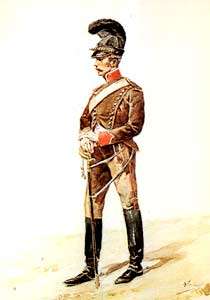Portuguese Legion (Napoleonic Wars)
The Portuguese Legion (French Légion portugaise and Portuguese Legião Portuguesa) was the 9 000 men strong Portuguese military force integrated in the Napoleon's Imperial Armies, mobilized after the occupation of Portugal by the army of General Junot, in 1807.
| Portuguese Legion | |
|---|---|
 Cavalry soldier of the Portuguese Legion | |
| Active | 12 November 1807 |
| Disbanded | 5 May 1814 |
| Country | |
| Allegiance | Napoleon Bonaparte |
| Type | Foreign legion |
| Size | 9 000 Portuguese mobilized by the French occupiers Size reduced to about 4 500 after half of the Portuguese defected to join the Portuguese Resistance |
| Nickname(s) | Black Infantry |
| Engagements | Battle of Wagram Battle of Smolensk Battle of Vitebsk Battle of Borodino |
| Commanders | |
| Commandant (1808–1810) | Général de division Pedro José de Almeida Portugal, 3rd Marquis of Alorna |
| Commandant (1810) | Général de division José Carcome-Lobo |
| Commandant (1810–1814) | Général de division Gomes Freire de Andrade |
| Notable commanders | Général de brigade Francisco António Freire Pego |
The Legion was created by order of Napoleon from 12 November 1807. Organization began in February, 1808, with the best units of the disbanded Portuguese Army, including the elite Legion of Light Troops. It left to Salamanca in April 1808, crossing Spain until arriving in France. During the crossing of Spain, many legionnaires defected, returning to Portugal and joining the Portuguese resistance against the French occupation.
At the service of Napoleon, the Portuguese Legion fought in the campaigns of Germany, Austria and Russia, suffering heavy casualties. It was present in the battles of Wagram, Smolensk, Vitebsk and Borodino (Moscow). Being highly regarded by Napoleon, the troops of the Legion were referred by him as the "Black Infantry".
The Legion was disbanded at 5 May 1814, with only about 1000 of its soldiers surviving and returning to Portugal.
Organization
The Portuguese Legion was organized as a division, originally including:
- Five regiments of light infantry
- A battalion of chasseurs à pied
- Three regiments of chasseurs à cheval
- A battery of artillery
- An infantry depot battalion
- A cavalry depot squadron
For the 1809 campaign, the 13th Elite Demi-brigade was created, with three battalions, made from elements of the several infantry regiments of the Legion. The 13th Demi-brigade was part of Oudinot's II Corps.
In 1811, the Portuguese Legion was reorganized in:
- Three regiments of infantry
- A regiment of chasseurs à cheval
- A depot battalion
In 1813, after suffering heavy casualties, the remains of the Legion were organized as:
- A battalion de guerre
- A depot battalion
References
- Artur, Ribeiro, Legião Portuguesa ao Serviço de Napoleão (1808–1813), Lisboa, Ferin, 1901.
- Banha, Teotónio, Apontamentos para a História da Legião Portuguesa, Lisboa, 1863.
- Boppe, P., La Legion Portugaise 1807–1813, Paris, 1897, p. 497.
- Esdaile, Charles, The Peninsular War, London, 2003, pp. 28–29.